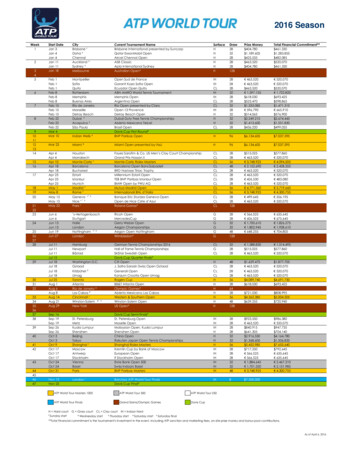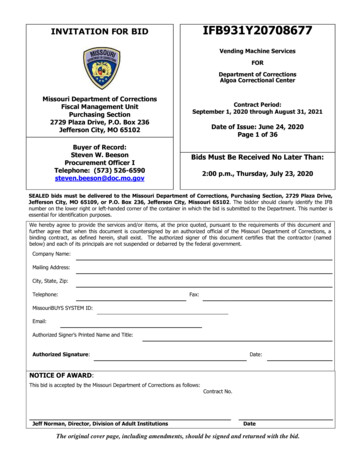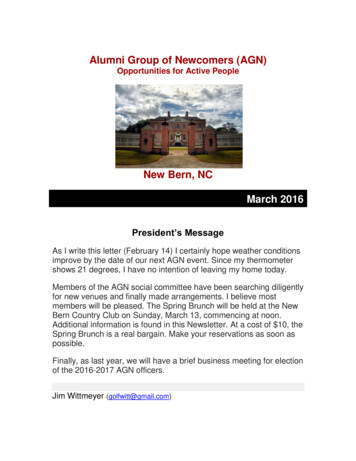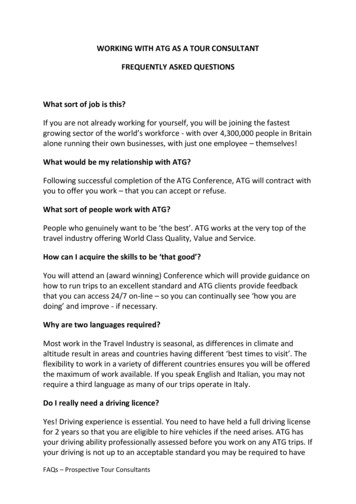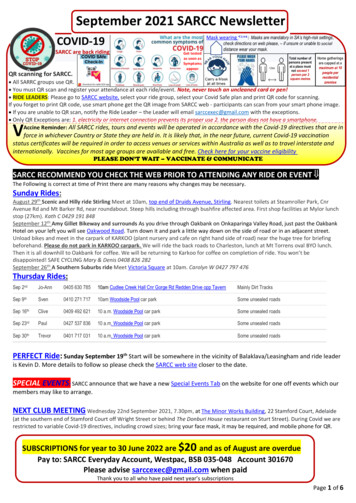
Transcription
·---- - -- - - - - - -··--1THE GENERAL'S TOUR1MISSSterlingI Price's1864Missouri' Expedition11Ii 'A Just ando y Cause'IbyI Scott E. SalleeI·--··-···-- -····--IStatue of General Sterllog Price, CSA, lo hla hometown of Keytesville, Mluourl.· (Photo by Dave Roth of B&G)-- - - - -- ·--·- --1·-··- ---------------- -
INTRODUCTIONMaj. Geo. Sterling Price's 1864 Missouri Expedition was the last majorcampaign west of the Mississippi duringthe Civil War. It was the longest cavalryaction of the war. lasting over threemonths and encompassing ()Ver 1,500miles. It was born of politics, plaguedthroughout by political considerationson both sides, and ended on theday Lincoln's reelection sweptpolitics out of the war. The r esults of the campaign were sodisastrous to the Confederacythat relative peace prevailed onthe Trans-Mississippi front uritllthe end of the war.Sterllng Prke was one of theleading politicians of antebellumMissouri. and throughout theCivil War he remained the trulyrepresentative figurehead of theConfederate element of the state.Price was bomln Virginia In 1809,and as a young man he movedw1th his family to Missouri wherethey settled at Keytesvllle, onthe Missouri River. He soon became a prosperous tobaccoplanter and slaveowner, and In1840 he was elected to the statelegislature. In 1842 he becameSpeaker of the Missouri House ofRepresentatives, and two yearslater secured a seat In the U.S.Congress.He was . notrenominated, however. andwhen the Mexican War broke outhe resigned his congressionalseat to command a cavalry regiment. At the end of the Mex.leanWar Price returned to Missouriwith the brevet rank of brigadiergeneral and a greatly enhancedreputation.In 1852 Price ran for governoron Missouri's pro-slavery factionof the Democratic party and wonby a substantial majority. His war record,plus his personal charm and Impressivephysique made him, according to onesupporter, uunquestlonably the mostpopular man In Missouri." Price occupiedthe governorship during the passage ofthe Kansas-Nebraska Act. and though herefrained from aiding the Missouri uBorder Ruffians" In their efforts to force slavery Into Kansas, he did nothing to restrain them.Though Price was pro-slavery he wasnot a secessionist. He was a Southernmoderate who opposed secession exceptas a last resort for the South to protectItself against "Northern aggression." Aswar approached, Price hoped the Unionwould be preserved, but Northern attempts to coerce Missouri to remain loyalforced Price into the Southern camp. HeImmediately took command of the state'ssecessionist force, the Missouri StateGuard, and led It to early victories atWilson's Creek and Lexington. He thenaccepted a commission as a major general for the Confederate government andurged his men to volunteer for .Confederate service.In 1862, afler the Federal victory at PeaRidge, Arkansas, Price and his division ofMissouri volunteers were transferred toMississippi where they fought in thebattles of Corinth and Iuka. Price wastransferred back to Arkansas In 1863, andI-- - - ---- -------- ---- ---- --the Trans-Mississippi's role as a supporting one.On March 16, 1864, Price was assignedto command the District of Arkansas, wt thheadquarters at Camden. He acceptedthe assignment even though he preferredto remain "footloose" to command anexpedition that he hoped would throwthe yoke of oppression off Missouri. andbring the state Into the Confederacy. Finally. in the fall of 1864, he wasgiven his chance. Gen. EdmundKirby Smith, commander of theSouth's Trans-Mississippi Department , made the decision tosend Price Into Missouri.Smith was born in Florida toNew England parents and was an1845 graduate of West Point andveteran of the Mexican War. Hisperformance in Virginia andKentucky early in the Civil Warled to his rapid promotion tolleutenantgeneral and commandof all the Confederacy west ofthe Mississippi River. From hisheadquarters In Shreveport,Louisiana. Smith commanded avast area that was far removedfrom the war's major area of operations, and the fall of VicksburgIn July 1863, further Isolated himfrom the rest of the Confederacy.Because of his tremendous responsibilities he was elevated tofull general In February 1864.After repulsing Federa.I forcesin the Red River Campaign InMay 1864, Smith began contemplating his next operation. Because Federal naval power madea move against New Orleans lmprac:tical. he proposed to destroythe Union outposts in northernArkansas,-then Invade Missouri.Accordingly he sent Brig. Gen.Jo Shelby Into northeastern ArSterllng Prtce, CSAkansas to attack the Federal supply line between Little Rock andparticipated In the attack on Helena, the Devall's Bluff, and to recruit for the comdefense of Little Rock, and In the Red ing campaign.River Campaign. He was as successful asSmith directed Price to gather supany other field commander In the Trans- plies and Intelligence in preparation for aMississippi, and the small degree of suc- northern offensive. But despite these Incess the Confederacy had gained in these structions Smith had no Intention of aloperations was usually due to hJs leader- lowing Price to lead the campaign. Of allship. His concern for the welfare of his Price's superiors, Smith was especiallytroops caused them to Idolize him, and contemptuous of him. Smith consideredthe Missourians gave him the affectionate Price "castoff material," Incapable of "ornickname of "Old Pap."ganizing, disciplining, nor operating anBut If Sterling Price was a military hero army." Smith had given Pric:e commandin the popular mind, he wasn't with his of the District of Arkansas with great resuperiors. He had been Involved in con- luctance, and hoped it would be onlytroversies with every general he had temporary.served with or under, and harbored reSmith hoped to launch the expeditionsentment toward all of hls civilian supe- about mid-August, when the troops.riors. up to and Including President Davis. horses and equipment used in the RedPrice was a politician whose military out- River Campalgn would be rested and relook was completely colored by his politi- fitted. His choice as commander had beencal aspirations. Throughout the war Maj. Gen. Richard Taylor, whom he rePrice's main objective was to free Mis- garded as the best general in his departsouri from Federal rule. This set him at ment. Though Taylor accepted the as- todds with his superiors, who looked upon signment and began outlining a plan of, J- - - ·---···---. ----·---··--·--- -- - . ' -·' -·----- - -- - -- --
--··--· ·- --------operations, afler quarreling with Smithover the conduct of the Red River Campaign, Taylor requested a transfer east.Smith did not Immediately find a replacement for Taylor, but he continued makingpreparations.Meanwhile top ranking Missouri olficlals In !avor or secession, b th politicaland mUltary leaders, were g.r owing concerned that the year would end without anattempt to expel Union forces from theirstate. For the past two years the TransMississippi Confederates had conductedseveral strategic cavalry raids into thestate from bases In Arkansas, each withvarying degrees of success. Fear that thepro-Southern element In Missouri wouldJose hope and reconcile themselves toUnion military rule, caused them to advocate another such movement morestrongly as the summer of 1864 wore on.On July 18, 1864, Thomas C. Reynolds,Missouri's Co11foderate governor -in xlie,wrote to Price and suggested a raid IntoMissouri. Reynolds felt a small scale raidwould be a favorable alternative in theabsence f a larger lnvasl n. PresidentDavis, Reynolds claimed, was .Impatientfor an advance Into Missouri" which, evenIf unsuccessful, would compe I the Unionto pull forces away from threatened pointsIn Virginia and Georgia. Also, the expedition would be aided by recruiting.Reynolds then asked Price lf he would bewilling to take command of the raid.Naturally Price concurred wholeheartedly with Reynolds' suggestion. On July23, Price sent a similar proposal to KirbySmith. Price. who believed from his numerous Intelligence sources that proSouthern sentiment in Missouri wasstrong, told Smith he was "assured thatthe Confederate flag floats o ver nearly allthe principal towns ol North Missouri,and large guerrllla parties are formed andoperating in the southern portion of thestate.tt Price believed that at l1e ast 30,000men could be recruited. Two days laterReynolds also wrote to Smith calllng for acavalry raid Into Mlssc1url.Meanwhile the eastern Confederacywas falllng Into a des per ate state of affairs.The summer of 1864 found Lee's Army ofNorthern Virginia lo( ked Jn the trenchesat Petersburg and Joe Johnston's Army ofTennessee retreating toward Atlanta. As aresult the Confederate high command began looking toward the Trans-Mississippito remedy, or at least re\leve the criticalsituation In the East. On July 22, Gen.Braxton Bragg, military advisor toJefferson Davis, was In Columbus, Georgia, evaluating the recent Confederatedefeats around Atlanta (where John BellHood had replaced Johnston). Bragg. recognizing the seriousness of the situation,sent a dispatch to Kirby Smith orderinghim to send Gen. Taylor's Infantry east,with other Infantry that could be sparedto follow later.The execution of thls rder was nearlyImpossible. It falled to conslder the individualistic nature of the rugged Trans-12Mississippi Confederate soldier. He possessed little sense of national loyalty tothe Confederacy and preferred to fight Inhis own section of the country where hecould be close to "Sarah and the c hll-dren," as one officer put ll.A!so, pollUcal leaders In Arkansas tooka firm stand against the muvement. Governor Harris Flanigan complained bitterly to President Davis, and SenatorAugustus Garland told Secretary of WarJames A. Seddon that the Arkansanswould wthrow down their armsft beforeobeying such an order. The men had notbeen paid In nearly a year, resulting Inlow morale and Increasing desertions.But above all the order failed to recognizethe difficulties of moving troops acrossthe Mississippi River, which was constantly patrolled by Union gunboats. . f .: . . r.' · .;.: · Alf;,. .John S. Marmaduke, CSASince Smith was unable to send hisInfantry east, the Mlss .iurl Expedltl nwas his only alternative c nlrlbutlon tothe war effort, and around the last of Julyhe decided to get It started. Smith wasencouraged by Price's favorable predictions and by the fact that nearly all of theUnion volunteer regiments that had beenraised ln Missouri had been sent east,which left only Inexperienced mllltlaunits scattered across the state. Also,guerrilla activity was so rampant that Itappeared Missouri seethed with revoltand was ready to join any major Confederate invasion.THE PLANDuring the first four days of August1864, Gens. Smith and Price, and Gover-nor Reynolds and other polltical leaders, met in Shreveport to work out thedetails of the expedition. Then, on August 4. Smith plal:ed Price Jn command.The choice was due In all probability tothe supposed Influence Price had In Missourl, In addition to the fact that he wasthe only officer of high enough rank whowanted It, and that Smith was afraid notto name him In view of the trouble thatmight have resulted. But on the otherside of the coln, Smith would get a newdistrict commander and be rid of Price, Ifonly for a while; Price, as commander ofthe expedition, was forced to rellnqulshcommand of the District of Arkansas. Hewas Immediately replaced by Maj. Gen.John Bankhead Magruder, and Price wasreassigned to command only the cavalry f the district.Despite Smith's decision to InvadeMissouri, he stlll ordered Taylor to attempt to move his Infantry east of theMississippi. Smith's abandonment of apotentially major offensive by sendinghis Infantry to attempt a crossing that heknew was Impossible, instead of sendingthem Into northern Arkansas to supportPrice's movements In Missouri. was Indicative of the lack of confidence he hadIn Price's ability.Smith or dered Price to conduct theInvasion with only the cavalry of the District of Arkansas, organized In three divisions commanded by Maj. Gen. James F.fagan and brigadiers John S. Marmadukeand Jo Shelby. St. Louis, with Its suppliesand military stores, was the primary objective, since acquiring It would Mdomoreto rallying Missouri, than the possessionof any other point." If forced to retreat.Price was to move through Kansas andIndian Territory and sweep the countryof livestock and mJlltary supplies, whilebrlnglng back as many recruits as possible. He was additionally Instructed to"scrupulously avoid all acts of wantondestruction and devastation," and t Impress upon his men that .their aim shouldbe to secure success In a just and holycause and not to gratify personal feelingsand revenge."Price pers .inally added a polltlcal objective- that of gaining control of enoughMissouri terrlt ry, at least temporarlly,to hold an election for a new governorand legislature. This would not only allowMissouri Confederates to keep alive theirclaim to the state, but also removeReynolds, a man Price had never beenfond of. Reynolds, legitlmatelyfearlng hisown civil authority might be supersededby mllltary authority under Price. decidedto accompany the expedition to keep aneye on events.Because of a delay ln obtaining ordnance stores, Price did not leave Camdenuntil August 28. The following day hearrived In Princeton. Arkansas, and assumed command of Fagan·s andMarmaduke's divisions. Price had previously ordered Shelby, who was stlll In· northeastern Arkansas, toattackDevall'sBluff and the railroad between Uttle Rockand the White River to divert the Federals'attention from his own movements. In anexploit that Price called "one ol the mostbrllllant of the war, tt Shelby captured six------·-·-·----------------------BLUE & GRAY MAGAZINE-JUNE 1991
··· ·- ··-- - · - - - - - - - - - - - - --forts and 400 prisoners, inflicted 300 casualties and destroyed ten miles of track.Though not part of Price's Instructions,the forays of Brig. Gen. Stand Watle'sInd Ian Brigade into southern Kansas alsohelped divert the Federals' atten lon.Price, Fagan and Marmaduke marchednorthward from Princeton on the morning of the 30th. Fearful that his delay instarting had alerted the Federals of hisIntended route, Price decided to crossthe Arkansas River above Little Rockrather t}lan below. After sending a feinting column across the Saline River heturned the main column towardDardanelle where It arrived on September 6. The men waded the Arkansas thefollowing day, the river being so low thatpontoons brought from Camden were notneeded. By raising the supplies on thewagons high enough the whole commandwas able to ford t)"ie river.Once across the Arkansas River.Price had overcome his first major obstacle-breaking through the thin llne o(Federal outposts along the river, underthe command of Ma). Gen. FrederickSteele. Price then moved northeast toward Batesvllle, Arkansas. with the twodivisions In separate columns. Alter minor skirmishing they reached the WhiteRiver, 18 miles above Batesville, on September 12, where Price learned that Gen.Shelby was at Powhatan, about 60 milesnortheast of Batesville on the route IntoMissouri. Price then decided on the townof Pocahontas as a rendezvous point, andwent to find Shelby.Despite the fact that northeast Arkansas abounded In sla1.:kers. deserters andbandits. Shelby had enrolled about 8,000men Into Confederate service, recruitingthose who wlshed to volunteer and conscripting those who d!d not. He Li:1e11Jo Shelby, CSA (pre"lously unpublished photo, courteay of Jacbon Couoty Historical Society. with special acknowledgment to Craig Higginbotham)-----placed them in camps of Instruction andorganized them Into regiments and brigades. After meeting Price near Batesv!lleon the 13th, Shelby ordered his command and the newly-formed units to report to Pocahontas the next day. Pricethen began organizing his Invasion force,which he named the "'Army ol Missouri.Ma). Gen. Fagan's Division, the largestIn the army, consisted of four brigades ofArkansans. James Fleming Fagan, a native of Clark County. Kentucky. had servedIn the Mexican War and ln the Arkansaslegislature. After Arkansas seceded hewas commissioned colonel of the 1st Arkansas Infantry, and his distinguishedconduct at Shiloh won him a promotionto brigadier general. He was then sentback to the Trans-Mississippi where hetook part In the battles of Prairie Grove,Helena and Little Rock. Though he prove dto b e of average m!litary ability. he wasnevertheless promoted to major generalprior to the Red River Campaign.The most formidable brigade In Fagan'sDivision was that ol Virginia-born Brig.Gen. William L. Cabell, whose nkkname"Old Tlge" (short for '"Tiger") reflectedhis nature. Cabell's Brigade was the largest brigade in the Army of Missouri. consisting of 2,800 ··number one" veteranswho were well mounted and armed mostlywith Enl!eld rifles, with only a small portion unarmed. Col. William Slemons· Brigade also consisted of veteran troops,but Fagan's other two brigades, those ofCols. Archibald S. Dobbin and Thomas H.McCray, consisted of regiments that hadrecently been recruited by Shelby.Another of Price's divisions was commanded by John Sappington Marmaduke,a member of one of Missouri's old aristocratic famllles. His lather, once governorof the state, sent him to Harvard and Yalebefore securing him an appointment toWest Point. Marmaduke graduated fromWest Point In 1857, and was serving onthe frontier when the war began.Marmaduke immediately resigned hissecond lieutenant's commission, and after serving briefly with the Missouri StateGua rd he accepted a commission fromthe Confederacy. His distinguished action as colonel of the 3rd AI kansas Infantry at Shiloh secured him a brigadier'scommis sion. and subsequent battles andraids In Missouri and Arkansas earnedhim a reputation as a hard fighter.The backbone of Marmaduke's Division was his old brigade, now commandedby Brig. Gen. John B. Clark, Jr. Clark'sfather had served under Price as a division commander In the Missouri StateGuard In 1861, and he was later a Missourirepresentative in the Confederate Congress. Ably commanded, Clark's Brigadewconsisted of 1,200 men whose equipmentwas fair and horses In "moderate" condition. Marmaduke's other brigade, that ofCol. Thomas Freeman. consisted of Arkansans conscripted by Shelby.Joseph Orville "Jo" Shelby, commanderof Prlce's third division, was a native of----- - --- - -- ----·------ - ---- --·
iLexington, Kentucky. and a relative ofRevolutionary War hero and first governor of Kentucky, Isaac Shelby. Asa youngman Jo moved to Waverly. Missouri,where his rope manufacturing businessmade him one of the wealthiest men Inthe state. He participated In the Kansas·Missouri border forays of the late 1850s,and In 1861 he entered the Cuard as acaplaln of cavalry, fighting al Wilson'sCreek, Lexington and Pea Ridge. In thesummer of 1862 he recruited his famous"Iron Brigade" of Missouri cavalrymenand led them through battles Jn Arkan·sas. He was promoted to brigadier general for his dashing raid Into Missouri Inthe fall of 1863, and his recent campaignIn northeast Arkansas had further enhanced his reputation.Consequently the Iron Brigade, nowcommanded by Col. David Shanks, wasthe best outfit In the Army of Missouri. Itwas made up of 1.500 tough, battle-hard·ened Missourians, most of wh m carrieda revolver or two ln addition to a rifle orcarbine. Though lax In discipline, theywere rellable In battle and would provethe mainstay of the army throughout thecampaign. Shelby's other br gade, Col.Sidney D. Jackman's, consisted of 1,600men recentlyrecrulted In Miss ourI , three.fourths of whom were unarmed.Though the Army of Missouri was amounted force, the Iron Brigade was theonly real cavalry unit. The other unitswould serve as mounted Infantry. All told,Price had a force of 12,000 troops; however, the Army of Missouri was marred bya number of serious problems. About4,000 t roops were unarmed and l,000lacked mounts. Its arms, some ot whichwere issued, others captured or broughtfrom home, were a hodge-podge or calibers. which would make ammunitionresupply difficult.The army had 14 pieces of artillery,but they were all small calibers .and mostlysmooth bores. The major exception was afour-gun battery of Parrotts in Shelby'sDivision under the command of Capt. DickCollins, a hard-lighting artlllery officerwho believed in engaging his guns along·side thecavaJrymen, lfnot ahead of them.The baggage train, which conslsted ofabout 300 "wh zy" and rkkety wagonsand ambuiances, was indispensable forcarrylng supplies through a barren coun·try, but a serious Impediment to a cavalrycolumn. The brigade of Col. Charles Tyler,which consisted of the unarmed men,assisted teamsters with the wagon traln.Discipline was loose, and the newly·formed Arkansas brlgades--composedlargely of conscripts whose main desirewas to go home to Nancy and the baby"would shortly prove problematical.The Army of Missouri spent four daysat Pocahontas organizing. shoeing mulesand horses, distributing ammun1tlon andmaking other necessary preparations.Speeches were made, reminding the soldiers of the true purpose of the expedl·tlon and their expected conduct during·----------. -- . . .the mo ming of September 19, 1864.the army marched northward in threecolumns-Shelby on the left, Price andFagan with the baggage train In the center, and Marmaduke on the right-withIt. Onten to 30 miles between each column tomaxlmize the use of roads and avallab!llty of forage. That same day. all threecolumns crossed Into Missouri andheaded for Fredericktown, where theywere to rendezvous before moving on St.Louis. After minor sklrmlshlng by flanking columns, the army reassembled atFredericktown on the 25th. Price, for thefirst time In ove r two years. was back InMissouri. He was not unexpected.principally those under "Bloody Biii"Anderson, Immediately moved north ofthe Miss ouri River and began a campaignof ambush and robbery that placed thearea under a reign of terror and paralyzedrail transportation.DISASTER AT PILOT KNOBIt was said that In Missouri during theClvll War there were five seasons: Msprtng,summer, fall, Price's Raid, and winter."Since 1861. Price or other Missourianshad Intermittently raided Into the state.These raids usually, but not always, occurred In the late summer and fall . Sinceearly spring Price's Intentions to InvadeMissouri had been known through thelodges of the Order of the AmericanKnights, a Copperhead organization Inthe state. Rumors to this effect becamestronger as fall approached, and the ripening of corn added welght to lls probabll1ty.Also, the fact that guerrllla bands InMissouri were Increasing In size and ferocity helped support the belief that amaJor Confederate invasion was Imm!·nent. Price was known to utilize guerrillas In his operatlons, and after takingcommand of the expedition he had sentthe guerrlllas an order (actually a re·Maj. Gen. Wllllam Starke Rosecrans,who had been transferred to Missouri thepreceding fall after his defeat atChickamauga, commanded the FederalDepartment of Missouri, with headquar·ters at St. Louis. Through Intelligencereports and pure common sense he hadreason to believe an Invasion of his department was looming, but he did notknow when and where ll would come. Tomeet the expected emergency Rosecranshad managed to raise flve complete andas many more Incomplete regiments of12-month volunteers, and was promisedthe loan of several One Hundred Dayregiments from llllnols.Then, on September 3, 1864, afterlearning that Shelby was at Batesvillewaiting to be Joined by Price, Rosecransrequested of Maj. Gen. Henry W. Halleck,the army's Chief of Staff In Washington,that the XV I Corps be sent to his aid. Maj.Gen. Andrew J. Smith's division, whichwas moving up the Mississippi fromVicksburg to join Sherman In Georgia,was stopped at Cairo, llllnols, and ordered to St. Louis. Maj. Gen. Joseph A.Mower's division, which had been sent toUttle Rock In early September to protectthat city against Price, moved overland inpursutt on September 18.After learning that Price had cr ssedthe Arkansas River, but still unsure of hisexact route, Rosecrans ordered his district commanders at the Missouri postsof Springfield. SedaIla, Jefferson City andRolla to concentrate their militia forces.On September 24, Rosecrans receivedword that Shelby was In the vicinity orFarmington, Missouri. near Frederlcktown. Alarmed, Rosecrans ordered Brig.Gen. Thomas Ew1ng, Jr. commander ofthe Southeast District, to concentrate hisforces at Pilot Knob and Cape Girardeau.That day, Ewing took one brigade ofSmith's Infantry and moved south fromSt. Louis on the Iron Mountain Railroadtowards Its southern terminus at PUotKnob, patrolllng and strengthening thegarrisons at the bridges as they went.Ewing set up temporary headquarters atMineral Point where he learned that Pricewas at Fredericktown with a large force.On the 25th, Ewing took one regiment andmoved by rail to Pllnt Knob where Maj.James Wilson had collected all the avail·able troops In the area. These two forcesgave Ewing an aggregate of about a thou-quest) to "make North Missouri as hotsand men.as . (they) could for the militia. This,Price hoped, would keep the Unionmilitia's attention away from southernMissouri and St. Louis. The gue:rlllas,Fort Davidson, a hexagonal shapedearthwork, was the main defensive position at Pilot Knob. It consisted of a ninefoot dirt parapet topped with sandbags,Wllllam S. Rosecrans, USA.·--·---------14·· -.- ·- -- - - ··-·- -- - - - -BLUE & CRAY MAGAZINE- JUNE 1991
with it.s slx sides surrounded by a moatThough the Federals fought desperatelyten feet wide and over slx feet deep, parto hold the gap between Pilot Knob andShepherd's Mountain, they were forcedtially filled with rain water. Two rl!le pitsran several hundred yards from the fortback within the walls of Fort Davidsonwhere the rest of the garrison was preto the southwest and north. TI1e fortmounted four 32-pound siege guns, threeparing for the anticipated attack.24-pound howitzers. three 12-lnch morOn the advice of his chief engineer.tars, and was bolstered by six field guns.Capt. T. J. Mackey, Price planned to shellA level plain. broken only by a drythe fort. But shortly after opening thecreekbed about 150 yarqs to t he southbombardment from atop Shepherd'sand east, extended from the fort for aboutMountain s ome local citizens asked hima thousand yards In all directions.not to shell It, claiming It would endangerThough the fort was seemingly Imthe lives of Southern adherents held prispregnable to an Infantry assault, It wasoner Inside. This Information, which Pricecommanded on three sides by mountains,apparently did not confirm, undoubtedlythe most prominent of which were Pilotled him to a gree with Fagan andKnob and Shepherd's Mountain. BothMarmaduke, who had advocated a direct assault. Price ordered the twowe re located about a thousand yardssouth of the fort, with a narrow passdivision commanders to prepare forseparating them, and accurate sniper andan attack.artlllery fire from these heights couldMarmaduke deployed his division onsvvu rattda1 :!&e :vr·t ua.:e a !e. Ew ngtho ::c :-th :;!ojX ! Sh'3phe: ': .1c :: !:-:had chosen the site because a better oneand Fagan took a position to his right.could not be found. He had the trailsCabel.l's Brigade occupied the gap beleading up the mountaJns obstructed and This monument lu Ironton, Missouritween the two mountains, with McCray'sand Slemons' brigades at the base of Piiotthe hillsides facing the fort cleared of mark: the spot In present-day Eme rsonKnob. Dobbin's Brigade was positionedtimber. His Instructions from Rosecrans Park where Col. Ulyuea S. Grantwere to hold the fort against any detach- received hl comml .lon u a brigadiernorth of the fort to block Potosi Road. thegeneral In 1861. Erected In 1886 by tbefort's only practical esca.p e route. Drawment of the enemy, but to evacuate If the survivor of the 2ht ntlnols Infantry.main force moved against him.ing on his past experiences. Price persontbe lnacrlptlon reads, "Let us haveally emphasized to Marmaduke's andThat same Tuesday, September 25. peace." (Photo by Dave Roth of D&G)Price conferred with his division comFagan's officers the need for coordination, stressing that both divisions mustmanders as to the expedition's futurecourse of action. He had received word pass called Shut-In Gap, several mUes assault simultaneously and In line.Before ordering the attack, Price calledtha t St. Louis was heavily defended and east of Arcadia. After heavy skirmishingof Ewing's presence at Piiot Knob. Shelby, the Confederates seized t he gap and on Ewing twice to surrender. Ewing rethe junior division commander, wanted pressed toward Arcadia with the further fused, believing he could hold out. Heto push Immediately to St. Louis. His Intention of moving northward through also had strong personal reasons for notscouts had reconnoitered Pilot Knob, and Ironton to Pilot Knob. Ewing. however, wanting to be captured. While commandhe did not believe It would justify the cost reinforced a detachment he had placed at ing the District of the Borde r In 1863. heof an assault. Marmaduke and Fagan, ironton and put Wilson In command; this had Issued the infamous Order No. 11however, urged that Ewlng be disposed force drove the Confederates back toShut- from his headquarters In Kansas City.of before advancing on St. Louis. Price ln Gap. Then Fagan, closely supported by This o rder, Issued In the wake of WIHlamdecided on the latter course, ostensibly Marmaduke, drove the Federals back to Quantrlll's raid on Lawrence, Kansas, rebecause he did not want to leave a garri- Arcadia where rain and darkness ended quired the mass eviction of citizens fromfour border counties In western Missouri,son In his rear; but In all llkellhood he the fighting.At daylight
when the Mexican War broke out he resigned his congressional seat to command a cavalry regi ment. At the end of the Mex.lean War Price returned to Missouri with the brevet rank of brigadier general and a greatly enhanced reputation. In 1852 Price ran for governor on Misso



